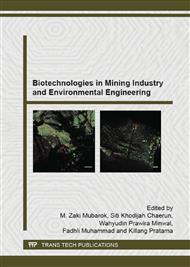p.40
p.45
p.50
p.55
p.59
p.63
p.67
p.71
p.75
Neutrophilic Microbial Community with High Rate of Elemental Sulfur Oxidation
Abstract:
Using molecular genetic methods, 10 species wereidentified in the community of neutrophilic microorganisms isolated from thebioreactor during the process of biooxidation of gold-arsenicpyrrhotite-bearing sulfide ore flotation concentrate. The microbial communitywas composed of chemolithotrophs oxidizing elemental sulfur and its reducedcompounds and chemoorganotrophs. The predominant S0-oxidizingchemolithotrophic strain and 3 strains of chemoorganotrophs were isolated inpure cultures. Phylogenetic identification of the pure cultures revealed thechemolithotrophic microorganism to belong to Thermithiobacillus tepidarius,while organotrophic microorganisms were identified as Parapedobacter sp.,Nocardioides nitrophenolicus, and Nocardioides sp. Themorphological and physiological characteristics of Thermithiobacillustepidarius and Nocardioides nitrophenolicus, the culturespredominant in the community of neutrophilic microorganisms, were studied.Active growth of T. tepidarius occurs within a temperature range of38–48°C at the optimal pH value of 7.0–7.5. The maximal specific growth rate ofT. tepidarius on sulfur and on solid residue which remains after theprocess of bioleaching/biooxidation of sulfide ore flotation concentrate (biooxidationresidue) was 0.13 and 0.135 h-1, respectively. The average maximalrate of S0 oxidation in the biooxidation residue was 0.107 g S0oxidizedper g S0initial h-1. The ability of Nocardioidesnitrophenolicus to destruct thiocyanate was shown.
Info:
Periodical:
Pages:
59-62
Citation:
Online since:
November 2015
Price:
Сopyright:
© 2015 Trans Tech Publications Ltd. All Rights Reserved
Share:
Citation:


